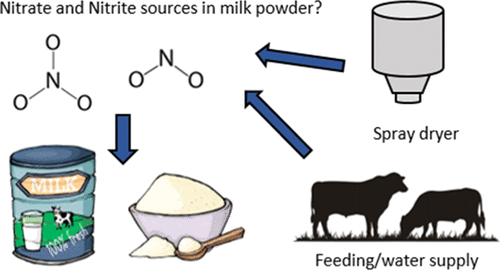当前位置:
X-MOL 学术
›
J. Agric. Food Chem.
›
论文详情
Our official English website, www.x-mol.net, welcomes your feedback! (Note: you will need to create a separate account there.)
Investigation into the Concentrations and Sources of Nitrates and Nitrites in Milk and Plant-Based Powders.
Journal of Agricultural and Food Chemistry ( IF 6.1 ) Pub Date : 2020-02-03 , DOI: 10.1021/acs.jafc.9b07460 Susan Genualdi 1 , Mayara P V Matos 1 , John B Mangrum 1 , Lowri DeJager 1
Journal of Agricultural and Food Chemistry ( IF 6.1 ) Pub Date : 2020-02-03 , DOI: 10.1021/acs.jafc.9b07460 Susan Genualdi 1 , Mayara P V Matos 1 , John B Mangrum 1 , Lowri DeJager 1
Affiliation

|
Milk powders in the United States (US) may contain nitrates and nitrites from several potential sources. These sources include the ingestion of nitrates and nitrites by dairy cows during grazing and drinking, nitric acid used during the sanitization of dairy equipment, and the production of nitrous oxides in directly heated spray dryers. Recently, milk powders manufactured in the US have been rejected during import to other countries because nitrite concentrations were greater than 2 mg/kg (ppm). To date, the concentrations of nitrates and nitrites in milk and plant-based powders in the US are unknown. In this study the nitrate and nitrite concentrations present in diverse milk powders were investigated including 81 milk powders from local and online retailers from 2015 to 2018. In addition, 71 commercial milk powders were obtained from blinded production facilities. Nitrate and nitrite concentrations were determined using ion chromatography with conductivity and UV detection. A subset of samples was analyzed for N-nitrosodimethylamine using gas chromatography-mass spectrometry. Carbon and nitrogen bulk isotope ratios analyzed using isotope ratio mass spectrometry were used to obtain some insights into the production method (organic vs conventional) and geographic source of the milk powder samples. Background nitrate concentrations in US-produced milk powder samples averaged 17 ± 12 mg/kg. Nitrite was detected at concentrations greater than 2 mg/kg in 5 out of 39 different brands of retail milk and plant-based powders. Of these brands, two were plant-based (soy and coconut) powders and the other three had consistently high nitrites. The analysis of milk powders using stable isotope analysis revealed further information about the cow's diet.
中文翻译:

牛奶和植物粉中硝酸盐和亚硝酸盐的浓度和来源的调查。
美国(美国)的奶粉可能含有来自多种潜在来源的硝酸盐和亚硝酸盐。这些来源包括奶牛在放牧和喝水时摄入的硝酸盐和亚硝酸盐,在消毒奶制品设备中使用的硝酸以及在直接加热的喷雾干燥器中产生的一氧化二氮。最近,由于亚硝酸盐的浓度大于2 mg / kg(ppm),因此在进口到其他国家/地区的美国生产的奶粉已被拒绝。迄今为止,在美国,牛奶和植物粉中硝酸盐和亚硝酸盐的浓度尚不清楚。在这项研究中,调查了从2015年到2018年来自本地和在线零售商的81种奶粉,其中包括各种奶粉中的硝酸盐和亚硝酸盐浓度。此外,从封闭的生产设施中获得了71种商业奶粉。使用具有电导率和UV检测的离子色谱法测定硝酸盐和亚硝酸盐的浓度。使用气相色谱-质谱法分析了一部分样品的N-亚硝基二甲胺。使用同位素比质谱法分析碳和氮的总同位素比,以了解奶粉样品的生产方法(有机与常规)和地理来源。美国生产的奶粉样品中的背景硝酸盐浓度平均为17±12 mg / kg。在39种不同品牌的零售奶粉和植物粉中,有5种检测到亚硝酸盐的浓度大于2 mg / kg。在这些品牌中,有两个是植物基粉末(大豆和椰子),而另外三个则始终具有较高的亚硝酸盐含量。
更新日期:2020-02-04
中文翻译:

牛奶和植物粉中硝酸盐和亚硝酸盐的浓度和来源的调查。
美国(美国)的奶粉可能含有来自多种潜在来源的硝酸盐和亚硝酸盐。这些来源包括奶牛在放牧和喝水时摄入的硝酸盐和亚硝酸盐,在消毒奶制品设备中使用的硝酸以及在直接加热的喷雾干燥器中产生的一氧化二氮。最近,由于亚硝酸盐的浓度大于2 mg / kg(ppm),因此在进口到其他国家/地区的美国生产的奶粉已被拒绝。迄今为止,在美国,牛奶和植物粉中硝酸盐和亚硝酸盐的浓度尚不清楚。在这项研究中,调查了从2015年到2018年来自本地和在线零售商的81种奶粉,其中包括各种奶粉中的硝酸盐和亚硝酸盐浓度。此外,从封闭的生产设施中获得了71种商业奶粉。使用具有电导率和UV检测的离子色谱法测定硝酸盐和亚硝酸盐的浓度。使用气相色谱-质谱法分析了一部分样品的N-亚硝基二甲胺。使用同位素比质谱法分析碳和氮的总同位素比,以了解奶粉样品的生产方法(有机与常规)和地理来源。美国生产的奶粉样品中的背景硝酸盐浓度平均为17±12 mg / kg。在39种不同品牌的零售奶粉和植物粉中,有5种检测到亚硝酸盐的浓度大于2 mg / kg。在这些品牌中,有两个是植物基粉末(大豆和椰子),而另外三个则始终具有较高的亚硝酸盐含量。



























 京公网安备 11010802027423号
京公网安备 11010802027423号